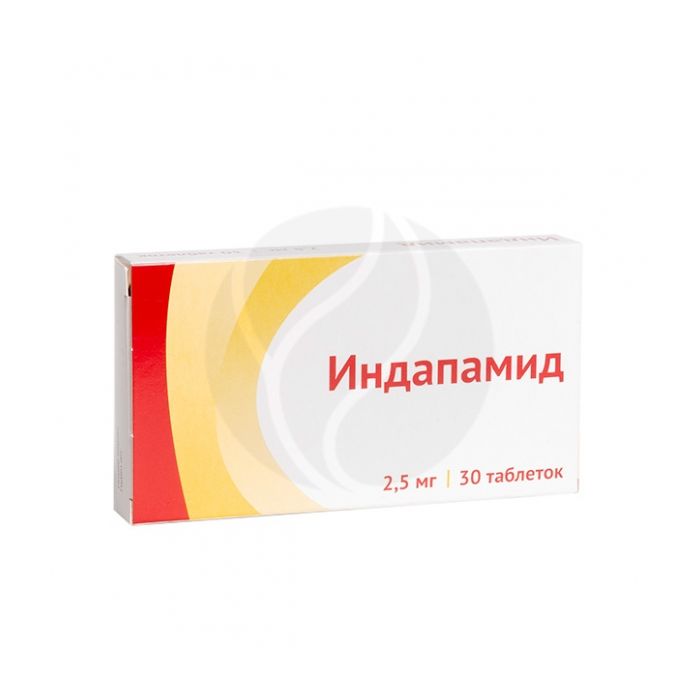Indapamide tablets 2.5mg, No. 30
Expiration Date: 05/2027
Russian Pharmacy name:
Индaпамид таблетки 2.5мг, №30
Arterial hypertension;
sodium and water retention in chronic heart failure.
Is taken orally 2.5 mg 1 time / day (in the morning). In case of insufficient severity of the hypotensive effect after 2 weeks of treatment, the dose is increased to 5-7.5 mg / day.
The maximum daily dose is 10 mg, divided into 2 doses (in the morning).
indapamide
Acute violation of cerebral circulation,
severe renal and / or liver dysfunction,
severe forms of diabetes and gout,
hypersensitivity to indapamide.
pharmachologic effect
Thiazide-like diuretic, antihypertensive agent. It causes a decrease in the tone of the smooth muscles of the arteries, a decrease in OPSS, also has a moderate saluretic activity due to a violation of the reabsorption of sodium, chlorine and water ions in the cortical segment of Henle's loop and the proximal convoluted tubule of the nephron. The decrease in OPSS is due to several mechanisms: a decrease in the sensitivity of the vascular wall to norepinephrine and angiotensin II; increased synthesis of prostaglandins with vasodilating activity; inhibition of the influx of calcium ions into the smooth muscle elements of the vascular wall. In therapeutic doses, it practically does not affect lipid and carbohydrate metabolism. The antihypertensive effect is manifested only with initially elevated blood pressure, develops by the end of the first week and reaches a maximum after 3 months of systematic administration.
Pharmacokinetics
After oral administration, it is rapidly and completely absorbed from the gastrointestinal tract, Cmax in plasma is achieved after 1-2 hours. Plasma protein binding is 79%. It is widely distributed in the body. Does not cumulate. T1 / 2 is 18 hours. It is excreted by the kidneys mainly in the form of metabolites, 5% - unchanged.
Side effect
From the digestive system: nausea, discomfort or epigastric pain. From the side of the central nervous system: weakness, fatigue, dizziness, nervousness. On the part of the cardiovascular system: orthostatic hypotension. From the side of metabolism: hypokalemia, hyperuricemia, hyperglycemia, hyponatremia, hypochloremia. Allergic reactions: skin manifestations.
Application during pregnancy and lactation
Adequate and well-controlled studies of the safety of the use of indapamide during pregnancy and lactation have not been conducted.
The use in this category of patients is not recommended.
Application for violations of liver function
Contraindicated in severe liver dysfunction.
Application for impaired renal function
Contraindicated in severe renal impairment.
special instructions
It is used with caution in patients with diabetes mellitus (glucose control is necessary, especially in the presence of hypokalemia), gout (an increase in the number of attacks is possible), in patients with a history of allergic reactions to sulfonamide derivatives. During treatment, it is necessary to control the level of electrolytes in the blood plasma (potassium, sodium, calcium).
Drug interactions
With the simultaneous use of GCS, tetracosactide for systemic use, the hypotensive effect decreases due to the retention of water and sodium ions under the influence of GCS. With simultaneous use with ACE inhibitors, the risk of developing hyponatremia increases. With simultaneous use with NSAIDs (for systemic use), it is possible to reduce the hypotensive effect of indapamide. With significant fluid loss, acute renal failure can develop (due to a sharp decrease in glomerular filtration). With simultaneous use with calcium preparations, hypercalcemia may develop due to a decrease in the excretion of calcium ions in the urine. With simultaneous use with cardiac glycosides, corticosteroids, the risk of hypokalemia increases. With the simultaneous use of drugs that can cause hypokalemia (amphotericin B,gluco- and mineralocorticoids, tetracosactide, laxatives that stimulate intestinal motility), the risk of hypokalemia increases. With simultaneous use with tricyclic antidepressants (including imipramine), the hypotensive effect increases and the risk of orthostatic hypotension increases (additive effect). With simultaneous use with astemizole, bepridil, erythromycin (i / v), pentamidine, sultopride, terfenadine, vincamine, quinidine, disopyramide, amiodarone, bretilium tosylate, sotalol, there is a risk of developing arrhythmias of the 'pirouette' type. When used simultaneously with baclofen, the hypotensive effect is enhanced. With simultaneous use with halofantrine, the likelihood of cardiac arrhythmias (including ventricular arrhythmias of the 'pirouette' type) increases.With simultaneous use with lithium carbonate, the risk of developing the toxic effect of lithium increases against the background of a decrease in its renal clearance. With simultaneous use with metformin, the appearance of lactic acidosis is possible, which is apparently associated with the development of functional renal failure due to the action of diuretics (mainly 'loop'). With simultaneous use with cyclosporine, an increase in the content of creatinine in the blood plasma is possible, which is observed even with a normal content of water and sodium ions.due to the action of diuretics (mainly 'loop'). With simultaneous use with cyclosporine, an increase in the content of creatinine in the blood plasma is possible, which is observed even with a normal content of water and sodium ions.due to the action of diuretics (mainly 'loop'). With simultaneous use with cyclosporine, an increase in the content of creatinine in the blood plasma is possible, which is observed even with a normal content of water and sodium ions.
'
